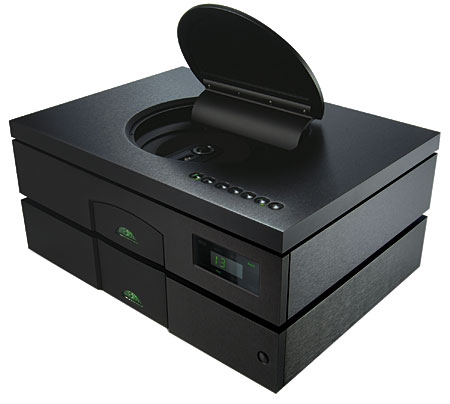| Columns Retired Columns & Blogs |
Naim CD555 CD player
Naim's new "statement" CD player, the CD555 ($20,300 by itself, $28,150 with PS555 power supply), breaks no new technological ground. Rather, in typical Naim fashion, it attempts to optimize 16-bit/44.1kHz CD performance by paying fanatical attention to the devilish details. It doesn't play the DVD-Video, DVD-Audio, or SACD formats, nor does it have a digital output—and it doesn't create an illusion of higher resolution by upsampling the data.

Encased in an almost forbiddingly heavy, precision-milled box of black aluminum with edges that are almost sharp as razors, the CD555 exudes all the mystery of some Fortress of Solitude. Two multipin cables made by Burndy—one each for the analog and digital circuits—connect the CD555 to the 555PS power supply ($7850), which is another dense, sharp-edged brick of black, brushed aluminum. The 555PS can be used with any Naim CD player made from 1998 to the present day. It has seven regulated power supplies, five secondary transformer windings, a 40% larger transformer than its predecessor (Naim's XPS2), and a low-resonance case with isolating feet.
The CD555's motorized, top-mounted disc door runs silently and smoothly, and seals tightly to shut out ambient light. Its clamshell design replaces the swing-open, front-mounted disc drawers of earlier Naim players. If you set the CD555 by itself on a lower shelf of an equipment rack, you'll need a between-shelves distance of about 9" for the door to clear. The disc transport itself is a Philips Pro with a diecast chassis; it resides in a heavy, machined tray designed to reduce resonances. Paint that minimizes the reflection of infrared light coats the tray area to reduce interference from stray light from the player's laser.
Pacific Microsonics' PMD200 chip handles digital filtering, which means the CD555 will recognize and decode HDCDs, while vintage (ie, introduced in 1998) Burr-Brown PCM 1704 DACs convert the digital signal to analog. There's a separate, triple-regulated, low-jitter clock circuit with its own multistage regulated power supply, sourced from a transformer secondary winding, and a post-digital filter circuit that Naim says virtually eliminates jitter.
Discrete components handle the current-to-voltage conversion, seven-pole analog filtering, and analog output stages. The digital circuit boards are made with surface-mount technology, the analog boards with the more conventional "through-hole" construction.
Three independent leaf-suspension systems, each tuned to a different frequency, isolate the analog and digital board assemblies and the CD tray. In designing the separately suspended analog and digital assemblies, Naim situated the analog-regulation board below the one that handles the analog signal in order to maintain a stable operating temperature. On the digital side, the regulation board is over the signal-processing board because that arrangement results in the most stable operating temperature. The DACs are mounted in what Naim calls a "quiet room"—an environment shielded to prevent varying electrical and magnetic fields from interfering with the DACs' performance.
The cost of all of the engineering tweaks, the superb, bulletproof construction, and Naim's Apple Computer–like first-class industrial design, is $28,150. Do the CD555 and 555PS add up to a significant improvement in CD sound? Or is Naim merely repolishing their already established, admittedly impressive take on what most listeners acknowledge to be the compromised resolution of the "Red Book" CD standard? More than 20 years after the launch of the Compact Disc, are there any more data still to be extracted from a sound format of inherently limited resolution? After all, you can't get a 480i-resolution monitor to display a 1920x1080p high-definition picture no matter what you do, and CD's measured and sonic performance has already come a long way since the format's introduction. What's left to improve? The question is not rhetorical.
Setup and Use
Before the CD555 can be used, the transport screws used to secure the three suspension systems must be removed—without turning the heavy player over. That requires hanging it off the side of a table or other platform from various angles in order to gain access to all seven screws. Then, moving the player to its final destination results in a loud clatter as its heavy brass subassemblies bang around inside, even if you try to keep the player level. No harm done, but it's best to remove the screws as close as possible to where the player will permanently sit.
Speaking of sitting—if you do place the CD555 on a lower and/or poorly lit shelf, you'll find that its controls won't light up until you activate one of them, either directly or via the rugged remote control, with its illuminated LCD screen. Ditto the lack of illumination in the CD well itself, where you might find yourself fumbling in locating the spindle, and in placing the magnetic CD clamp atop it once the disc is in place. But all of these are minor inconveniences; I suspect most buyers will place the CD555 on a top shelf—where, indeed, such a top-shelf product deserves to reside.

Naim includes both RCA and DIN analog outputs, selectable via a few button-presses on either the remote or the player. You can use both outputs simultaneously, but Naim says the player won't sound as good that way, so don't. Naim supplies a set of DIN-to-RCA interconnects, which I used during the break-in period and for my initial listening. However, in order to remove one unknown variable, I eventually switched to a set of TARA Labs The Zero interconnects fitted with RCAs. The resulting sonic improvement was enormous, and as described in my review of The Zero in the December 2006 Stereophile. A cable that handles attack, sustain, and decay as effectively as The Zero does well serves Naim's signature sound, as described in the next paragraph.
- Log in or register to post comments



































